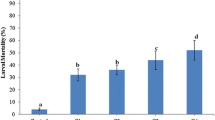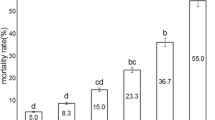Abstract
The present research dealt with the toxicity of GCSC-BtA (Germany–China Scientific Cooperation-Bacillus thuringiensis-Abamectin), a new type biocide developed by conjugating a toxin from Bacillus thuringiensis (B.t.) with Abamectin from Streptomyces avermitilis, on arthropod pests under different temperature conditions. The results showed that GCSC-BtA possessed higher toxicity than B.t. crystal, Abamectin or Cypermethrin, with pest mortalities of 97.9, 93.7, 96.4, 82.3 and 96.7% for Tetranychus cinnabarinus (Boisd.) (Acari, Tetranychidae), Frankliniella occidentalis Pergande (Thys., Thripidae), Aphis fabae Scopoli (Hom., Aphididae), Plutella xylostella (L.) (Lep., Plutellidae) and Cameraria ohridella Deschka et Dimić (Lep., Gracillariidae), respectively. Toxicities of GCSC-BtA to T. cinnabarinus and P. xylostella decreased significantly at the older developmental stage with an exception that egg stage had the highest tolerance, in which LC50s of GCSC-BtA were 0.0001, 0.0019 and 0.0708 mg/ml for nymph, adult and egg of T. cinnabarinus, and that 0.0399, 0.2035 and 0.9033 mg/ml for the 2nd instar larvae, 4th instar larvae and egg of P. xylostella, respectively. Also, the biocide was more effective to the lower stage of A. fabae than the higher one with LC50s of 0.0023, 0.0086 and 0.0171 mg/ml against 1st instar nymph, 3rd instar nymph and adult, respectively. In general, toxicity of the new type of biocide was positively related to temperature against all the tested pests, except against T. cinnabarinus, where it was almost similar at the three temperature conditions. GCSC-BtA displayed significantly lower toxicities at 15/20°C than 20/25°C or 25/30°C against F. occidentalis, A. fabae, P. xylostella and C. ohridella. However, no significant difference was found in the toxicities against F. occidentalis, A. fabae and C. ohridella above 20°C, whereas toxicity against P. xylostella increased as temperature raised. Therefore, to achieve higher efficacy in the field, application rate and time should be devised according to these factors.



Similar content being viewed by others
References
Abbott WS (1925) A method of computing the effectiveness of an insecticide. J Econ Entomol 18:265–267
Ali A, Young SY (1996) Activity of Bacillus thuringiensis Berliner against different ages and stages of Helicoverpa zea (Lepidoptera: Noctuidae) on cotton. J Entomol Sci 31(1):1–8
Ali ASA, Watson TF (1982) Effects of Bacillus thuringiensis var. kurstaki on tobacco budworm Lepidoptera: Noctuidae adult and egg stages. J Econ Entomol 75(4):596–598
Asano S, Iwasa T, Seki A (1997) Silkworm assay for Bacillus thuringiensis formulations using the diet incorporation method. 1. Evaluation based on larval mortality. Jpn J Appl Entomol Zool 41(4):187–194
Bandani AR, Butt TM (1999) Insecticidal, antifeedant and growth inhibitory activities of Efrapeptins, metabolites of the fungus Tolypocladium. Biocontrol Sci Technol (9):499–506
Beers EH, Andersen A, Brown RD (1996) Effect of leaf age on length of residual activity of abamectin in pome fruit foliage. J Econ Entomol 89(2):488–492
Bues R, Boudinhon L, Toubon JF (2003) Toxicity of insecticides on various development stages of pear psylla (Cacopsylla pyri L.). Fruits Paris 58(5):283–295
Christie PT, Wright DJ (1990) Activity of Abamectin against larval stages of Spodoptera littoralis Boisduval and Heliothis armigera Hübner (Lepidoptera: Noctuidae) and possible mechanisms determining differential toxicity. Pestic Sci 29(1):29–38
Corbitt TS, Green AStJ, Wright DJ (1989) Relative potency of Abamectin against larval stages of Spodoptera littoralis (Boisd.), Heliothis armigera (Hübn.) and Heliothis virescens (F.) (Lepidoptera: Noctuidae). Crop Prot 8(2):127–132
El-Banhawy EM, Anderson TE (1985) Effects of avermectin B1 and fenvalerate on the survival, reproduction, and egg viability of the two-spotted spider mite Tetranychus urticae Koch (Acari: Tetranychidae). Int J Acarol 11(1):11–16
Glare TR, O’Callaghan M (2000) Bacillus thuringiensis: biology, ecology and safety. Wiley, Chichester, p 350
He YX, Yang XJ, Weng QY, Huang J (2001) Biological toxicity of avermectin to Plutella xylostella. Fujian J Agr Sci 16(2):24–27
Izhar Y, Wysoki M, Gur L (1979) The effectiveness of Bacillus thuringiensis Berliner on Boarmia (Ascotis) selenaria Schiff. (Lepidoptera, Geometridae) in laboratory tests and field trials. Phytoparasitica 7(2):65–77
Johnson DL (1990) Influence of temperature on toxicity of two pyrethroids to grasshoppers (Orthoptera: Acrididae). J Econ Entomol 83(2):366–373
Li SY, Fitzpatrick SM, Isman MB (1995) Effect of temperature on toxicity of Bacillus thuringiensis to the obliquebanded leafroller (Lepidoptera: Tortricidae). Can Entomol 129:363–369
Liu B, Sengonca C (2002) Investigations on side-effects of the mixed biocide GCSC–BtA on different predators of Plutella xylostella (L.) (Lep., Plutellidae) in southeastern China. J Pest Sci 75(3):57–61
Liu B, Sengonca C (2003a) Conjugation of δ-endotoxin from Bacillus thuringiensis with abamectin of Streptomyces avemitilis as a new type of biocide GCSC-BtA in control of agricultural insect pests. J Pest Sci 76(2):44–49
Liu B, Sengonca C (2003b) Comparison of spatial niche breadth and overlap between predators and their preys, as pests in a cabbage field under the treatments of GCSC-BtA biocide and methomyl insecticide. Fujian J Agr Sci (China) 18(2):79–86
Liu B, Zhu YJ, Sengonca C (2005) Laboratory studies on effect of biocide GCSC-BtA on mortality and feeding damage of diamondback moth Plutella xylostella L. (Lep., Plutellidae) larvae on cabbage. J Plant Dis Prot (in press)
Reichenbach NE, Collins WJ (1984) Multiple logit analyses of the effects of temperature and humidity on the toxicity of propoxur to German cockroaches (Orthoptera: Blattelidae) and western spruce budworm larvae (Lepidoptera: Tortricidae). J Econ Entomol 77:31–35
Robertson JL, Worner SP (1990) Population toxicology: suggestions for laboratory bioassays to predict pesticide efficacy. J Econ Entomol 83(1):8–12
Sengonca C, Liu B (2001) Influence of mixed biocide GCSC-BtA on the pupae and adult stages of Apanteles plutellae Kurd. (Hym., Braconidae) and its host, Plutella xylostella (L.) (Lep., Plutellidae). J Pest Sci 74(6):145–149
Sengonca C, Liu B (2002) Effect of GCSC-BtA biocide on population dynamics of cabbage pests and their natural enemies from fields in southeastern China. J Pest Sci 75(2):46–50
Sengonca C, Liu B (2003) Effect of GCSC-BtA biocide on abundance and diversity of some cabbage pests as well as their natural enemies in southeastern China. J Plant Dis Prot 110(5):484–491
Sengonca C, Liu B, Zhu YJ (2001) Efficiency of the mixed biocide GCSC-BtA against vegetable pests of different arthropod orders in the southeastern China. J Pest Sci 74(2):33–36
Sengonca C, Liu B, Zhu YJ (2005) Insecticidal activity and antifeedant effect of a new type biocide GCSC-BtA against Plutella xylostella L. (Lep., Plutellidae). J Pest Sci (in press)
Tang QY (2001) Data processing system. Science Press, Beijing, p 648
van-Frankenhuyzen K (1990) Effect of temperature and exposure time on toxicity of Bacillus thuringiensis Berliner spray deposits to spruce budworm, Choristoneura fumiferana Clemens (Lepidoptera: Tortricidae). Can Entomol 122(1–2):69–75
van-Frankenhuyzen K, Nystrom CV (1987) Effect of temperature on mortality and recovery of spruce budworm (Lepidoptera: Tortricidae) exposed to Bacillus thuringiensis Berliner. Can Entomol 119(10):941–954
Wadleigh RW, Koehler PG, Preisler HK, Patterson RS, Robertson JL (1991) Effect of temperature on the toxicities of ten pyrethroids to German cockroach (Dictyoptera: Blattellidae). J Econ Entomol 84(5):1433–1436
Wang KY, Kong XB, Jiang XY, Yi MQ, Liu TX (2003) Susceptibility of immature and adult stages of Trialeurodes vaporariorum (Hom., Aleyrodidae) to selected insecticides. J Appl Entomol 127(9–10):527–533
Weintraub PG (1999) Effects of cyromazine and Abamectin on the leafminer, Liriomyza huidobrensis and its parasitoid, Diglyphus isaea in celery. Ann Appl Biol 135(3):547–554
Acknowledgements
The authors are grateful to the Deutsche Forschungsgemeinschaft (DFG) and BMZ of Germany and National Natural Science Foundation of China (NSFC) (PN: 30471175) for their supports.
Author information
Authors and Affiliations
Corresponding author
Additional information
Communicated by Andreas Vilcinskas
Rights and permissions
About this article
Cite this article
Zhu, Y.J., Sengonca, C. & Liu, B. Toxicity of biocide GCSC-BtA on arthropod pests under different temperature conditions. J Pest Sci 79, 89–94 (2006). https://doi.org/10.1007/s10340-005-0118-1
Received:
Revised:
Accepted:
Published:
Issue Date:
DOI: https://doi.org/10.1007/s10340-005-0118-1




